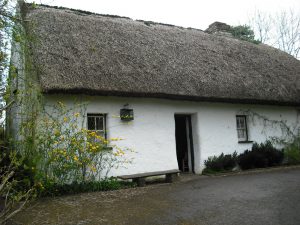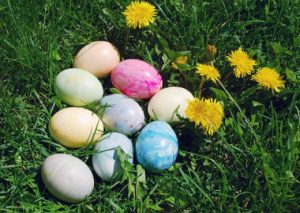
In and out the dusty bluebells by Hartney Photography – copyright http://www.hartneyphotographics.com
It’s the month where daffodils give way to bluebells – fields of lavender that threaten to distract me while driving as I peer in over ditches. They are a bright and welcome sight that cut the prevalent yellows of the early spring season.
The first few days of April are often referred to as the ‘borrowed’ or ‘borrowing’ days – meaning that they have borrowed the bad weather from March and that is certainly true of April this year. The borrowing days are supposed to last anywhere between 3-8 days so we should be out of them by Easter Monday! This saying comes from the old story of ‘An tSean Bho Riabhnach’ – the old brindled cow who laughed at the back of March’s weather as he managed to survive it only for it to be extended into April and skin him with its severity, for this reason these first few days were also called the ‘skinning days’ and by god I know the feeling after facing down a hail storm on April 3rd.
Lenten Fasting
We are all supposed to be fasting in preparation for Easter at this point, though it is rare to find many young folk observing this tradition these days. In days gone by though you would have done without all manner of goodies for the past few weeks and especially this week in the run up to Easter Sunday. All meat products were off the menu – that included eggs, milk, butter and all animal fats for frying. This was a particular hardship as vegetable oils had not yet been introduced to Ireland and milk was used to leaven the bread. As a result bread was made with a substitute of sourdough or yeast and those who did not have the skill or knowledge to make this type of bread made do with a flat oatcake type bread. Children under seven were allowed milk – but only if they cried for it three times! The Irish cottage diet for early April generally consisted of dry bread, potatoes, porridge, salted fish, onions and black tea – yum, who needs weight watchers!
These days the closest we get to abstinence is Good Friday where there is a ban on alcohol from midnight Thursday until midnight Friday – the horror! One of the funniest things you will see is the mad dash to the off licence around 9:30 Thursday evening as the masses prepare for the ultimate sacrifice – one day minus the pub. Abstinence from alcohol was not required throughout lent but many people observed it for the entire duration in sympathy with the suffering of Christ.
Palm Sunday
Held on the last Sunday before Easter, this year Palm Sunday fell on April 1st – also known as April Fool’s day. One member of each family would go to church to receive their blessed palm for the household to mark Jesus’s triumphal entry to Jerusalem. The palm was generally boughs from conifer tress like silver fir, spruce, cypress or yew trees. In some parts of the country it was tradition to bring your own palm bough to be blessed. Our palm always hung above ‘gods picture’ over the main fireplace in the living room for the week leading up to Easter Sunday and provided a lovely fresh scent as the heat rose at night.
Easter Week
Of course one of the main tasks in the run up to Easter was the spring clean. Inside the cottage, floors, windows, doors and children were scrubbed until there was not a speck of dirt to be seen, woodwork was painted and pots scoured. Cloths were mended or if the means allowed – new clothes procured, children in particular were to be paraded in their finest for mass on Easter Sunday morning.
Outside the house the walls of the cottage would get a fresh coat of lime wash, the farmyard and Byre were swept and cleaned for fear of the wrath of neighbours – not to make ones stead as clean as possible was seen as slovenly and unworthy.
Good Friday
Most people did not eat before mid-day on Good Friday and would go bare foot in sympathy with the plight of the saviour. From noon until 3pm was the time Christ was purported to have been hung on the cross and many chose to be silent during this time. No blood was to be shed, wood worked or nails to be driven during this solemn period.
Outside the cottage, the farmer would sew a small crop to invoke a blessing on his yields for the year and eggs laid on this day were marked with an X to be eaten on Easter Sunday. Chicks laid on Good Friday were said to become great laying hens. Good Friday was and is still the day that people visit the graveyard to pay respects to those who have passed away.
Fishing off all kinds was deeply frowned upon on – either by net or by boat so those living by the shore would indulge in ‘bia tragha’ – or shore food only – mussels, crabs etc…
Easter Saturday
Easter Saturday was the blessing of the holy water which was to be sprinkled on each member of the family, over the hearth of the cottage, the byre, farmyard, animals and crops to ward off illness and danger.
In place of meat during the Lenten season, the household would have feasted on salted herring and as a celebration of the end of their Lenten sacrifice the poor old herring would be impaled on a pike and marched through the town. This was a type of mock funeral, held on Easter Saturday with the fish being whipped by the locals until it had been shredded or was dumped into the water at the end of the procession – often called the whipping of the herring. I’ve never had the pleasure of seeing this ritual and have not even heard of it amongst the inhabitants of North Kerry but perhaps it still happens somewhere!
Easter Sunday
Dawn mass on Easter Sunday brought to an end the fasting as the entire village would gather on top of the hill to see the sun rising, symbolising the rising of the saviour from his grave. Children and those who didn’t want to look directly into the sunlight viewed the sun rising in a pan of clean water which was often sneakily agitated by the adults for effect to show ‘The dance of the sun’.
And so with religious matters mostly dealt with, it was time to eat. Eggs were the call of the day as they also symbolised fertility and growth – an altogether pagan view mixed in with Christianity, but that’s something us Irish do well – we don’t tend to fight or discard tradition, we just take bits of it and mould it around our current circumstances. Easter Sunday feast consisted of a plate of eggs – including the ones marked with the X from Good Friday – the more you ate – the better the boast! No one was to do without eggs that morning with the farmer’s wife making the gift of eggs to their labourers and poor neighbours. For the children, the mother often dyed the eggs and painted them bright colours to engage and amuse them and this may be where the chocolate Easter egg phenomenon arrived from.
With meat back on the menu – the Easter Sunday meal was a riotous affair of spring lamb or roast veal or kid and potatoes with lashings of butter. Even in my home today the tradition of roast lamb for Easter dinner is so strong that all would kick up a fuss if it was absent. Well off farmers would kill a cow especially for this feast and pass the lesser cuts down to their labourers and poorer neighbours which was where the tradition of eating Corned Beef and cabbage for some on Easter Sunday came from.
The young folk had a tradition called Clúdog or Clúideog – gathering eggs from neighbours and roasting them at the edge of the farm in the open air or in a dry shed. They later played games like rolling the eggs down a path – pitting their eggs against each other with the winner taking all. Again the eggs were painted for this ritual and the colourful shells were often kept for the May bush.
The Cake Dance
With the longer days and the end of the abstinence from socialising the whole community would come together on Easter Sunday night to partake of the Cake Dance. A large currant cake (also known as barnbrack) would be baked, festooned with ribbons and flowers and placed atop a central podium which everyone would dance around. Music and festivity was in the air and usually courting couples competed to be named the best dancers and thus win the cake at the end of the night – a great privilege though the cake was then divided amongst all the dancers. This tradition gave rise to the saying ‘That takes the cake’.
Easter Monday
Originally Easter Monday was a religious day of obligation meaning that there was no work that day, only mass. As a result it became a great day for markets and festivities, of course with such events came merriment and devilment. On seeing this – the bishop of Kildare & Leighlin – Dr. John Doyle petitioned to abrogate the day so it was no longer a day of obligation. This put an end to the great tradition of Easter Monday, though it has seen a comeback with it being a Bank Holiday in Ireland in lieu of Easter Sunday – just try seeing any religious figure taking that away!




Hi I’d just like to say I enjoyed reading the above traditions for Easter. A friend only recently told me about the egg eating at Easter and the boast as to who could eat the most. Her father used to tell her how people would line the row of egg shells up outside their door on the footpath to show the neighbours. She is a Limerick woman, I think the traditions survived much longer in the west than they have here in the East.